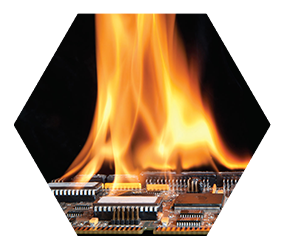Click "Allow Cookies" to consent to storing cookies on your device to improve your experience on our site. Learn more.
AccuStandard | Standards for Flame Retardant Testing
Brominated Flame Retardants (BFRs), such as polybrominated diphenyl ethers (PBDEs), have become global environmental contaminants because of their widespread use in numerous household and commercial products. They have been detected in sediments, biota, house dust, sewage sludge, air, water samples, and human and wildlife tissues. In the past years, an impressive amount of information has been gained on the persistence, bioaccumulative and toxic properties of PBDEs.
Find Flame Retardant Testing Standards by Type
Use the links below to navigate to a specific section.
PBDE Congeners (209)
PBDE Calibration Mixtures
Metabolites
Fluorinated PBDE Congeners
Phosphate Flame Retardants (PFRs)
Other Bromine Containing Flame Retardants (BFRs)
Other Flame Retardant Standards
Flame Retardant Standards by Type


In the past, commercial flame retardants were primarily technical BDE mixtures. The two most popular were the penta-BDE and the octa-BDE mixtures. These have been banned for commercial usage. However, because of their environmental persistence, they are still found in sediments, biota, household dust, sewage sludge, air, water, and in human and wildlife tissues. These products are a global environmental concern because they are bioaccumulative, persistent and toxic. AccuStandard was the first company in the world to synthesize all 209 possible congeners of these materials.


Calibration solutions are a cost effective way to screen for many different PBDEs at once. AccuStandard has mixes for EPA, ISO, DIS and individual State Methods.
Purchase PBDE Mixtures
Purchase ISO/DIS 22032 Calibration Curve Set
Purchase EPA Method 1614 Standards


In the environment when Polybrominated diphenyl ethers (PBDEs) are exposed to the elements, they form degradation products and metabolites, such as Hydroxy and Methoxy derivatives. The Metabolites of the parent PBDEs are what scientists commonly detect when studying the environmental impact of these chemicals. These compounds are not used as commercial products; they are by-products that are found as the result of PBDE pollution.
AccuStandard has synthesized many of the most commonly detected metabolites including methoxylated and hydroxylated metabolites of Tetradecabromodiphenoxybenzene (TDBDPB) which is a high molecular weight compound that was used as a flame retardant. We are committed on continuing our support to the scientific community by regularly adding new high-quality reference standards to test for these dangerous toxins.


Separating PBDE congeners is challenging due to the co-elution and nearly identical mass spectra. Using a traditional 13C labeled compound as an internal standard works well, but it is very expensive and does not work for electron capture detector methods (ECD). Using these fluorinated analogs is a cost effective way to utilize internal standards that elute near the native compounds and can be used in a wide range of analytical techniques.


Phosphorus-containing flame retardants (PFRs) are a halogen-free alternative to polybrominated diphenyl ethers (PBDEs). PBDEs are being banned and phased out due to their environmental persistence and possible human toxicity. PFRs are used as flame retardant additives in plasticizers, foams, hydraulic fluids, anti-foam agents and coatings for electronic components/devices. The widespread use of PFRs has raised concerns about their impact on the environment and animal health.


Brominated Flame Retardants (BFRs) are one of the most common flame retardant compounds used in a range of consumer and industrial applications. This class of chemical materials includes different brominated organic compounds such as Polybrominated diphenyl ethers (PBDEs), Hexabromocyclododecanes (HBCDDs), Tetrabromobispenol A (TBBPA) and other phenolic compounds. The widespread use of these chemicals in commercial products has resulted in their detection in water and air, as well as in human and wildlife tissues.
Other compounds of interest related to flame retardant analysis include:
Bromobiphenyl Congeners
Bromophenols
Bromoanisoles
Chlorine Containing Flame Retardants
Need Assistance with Flame Retardant Testing Standards?
To find additional commercial and other flame retardant products, you can browse all flame retardant standards here.
If you still don’t see what you are looking for, reach out to techservice@accustandard.com and we can make a recommendation or create a custom product for you.


